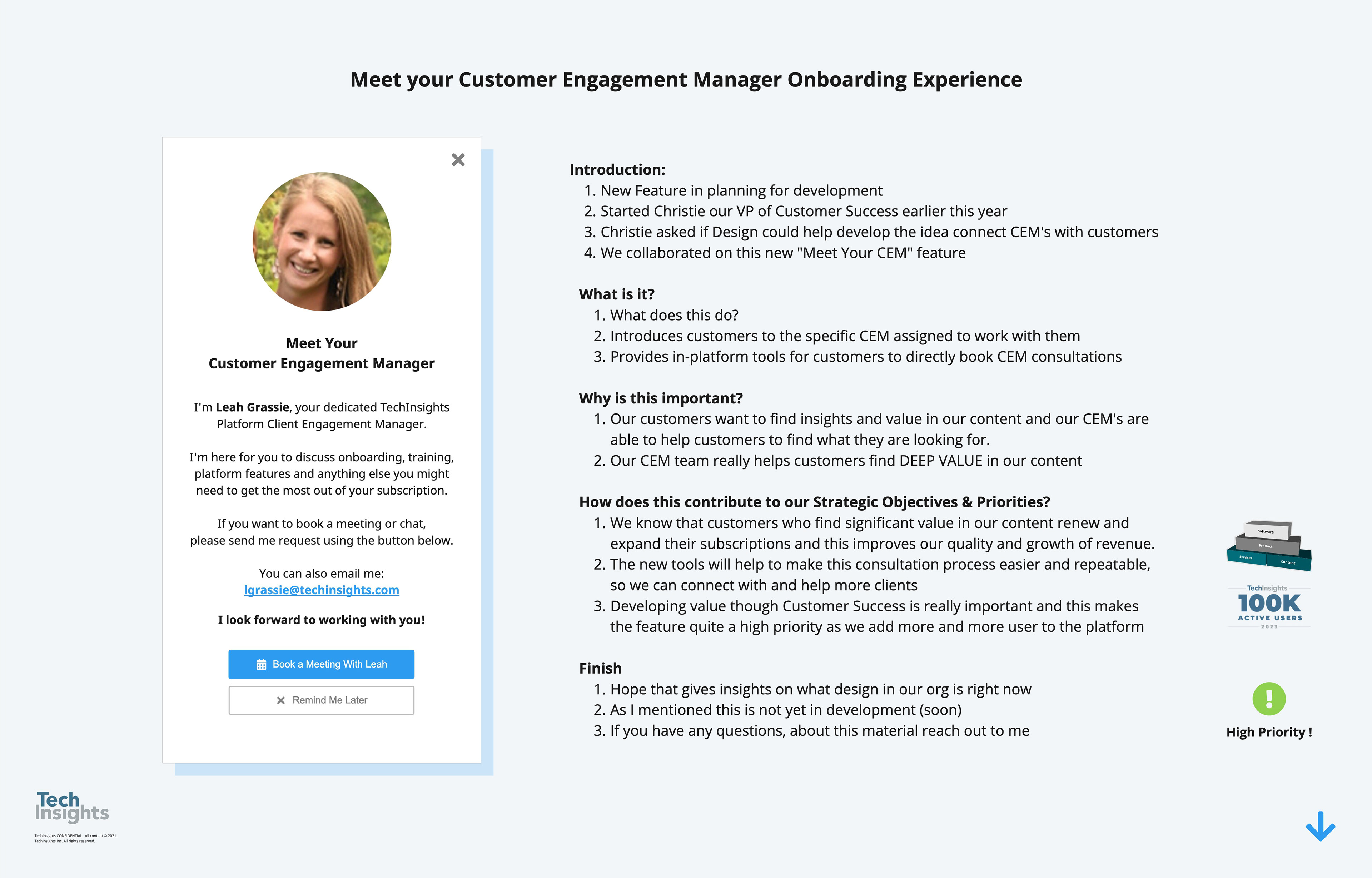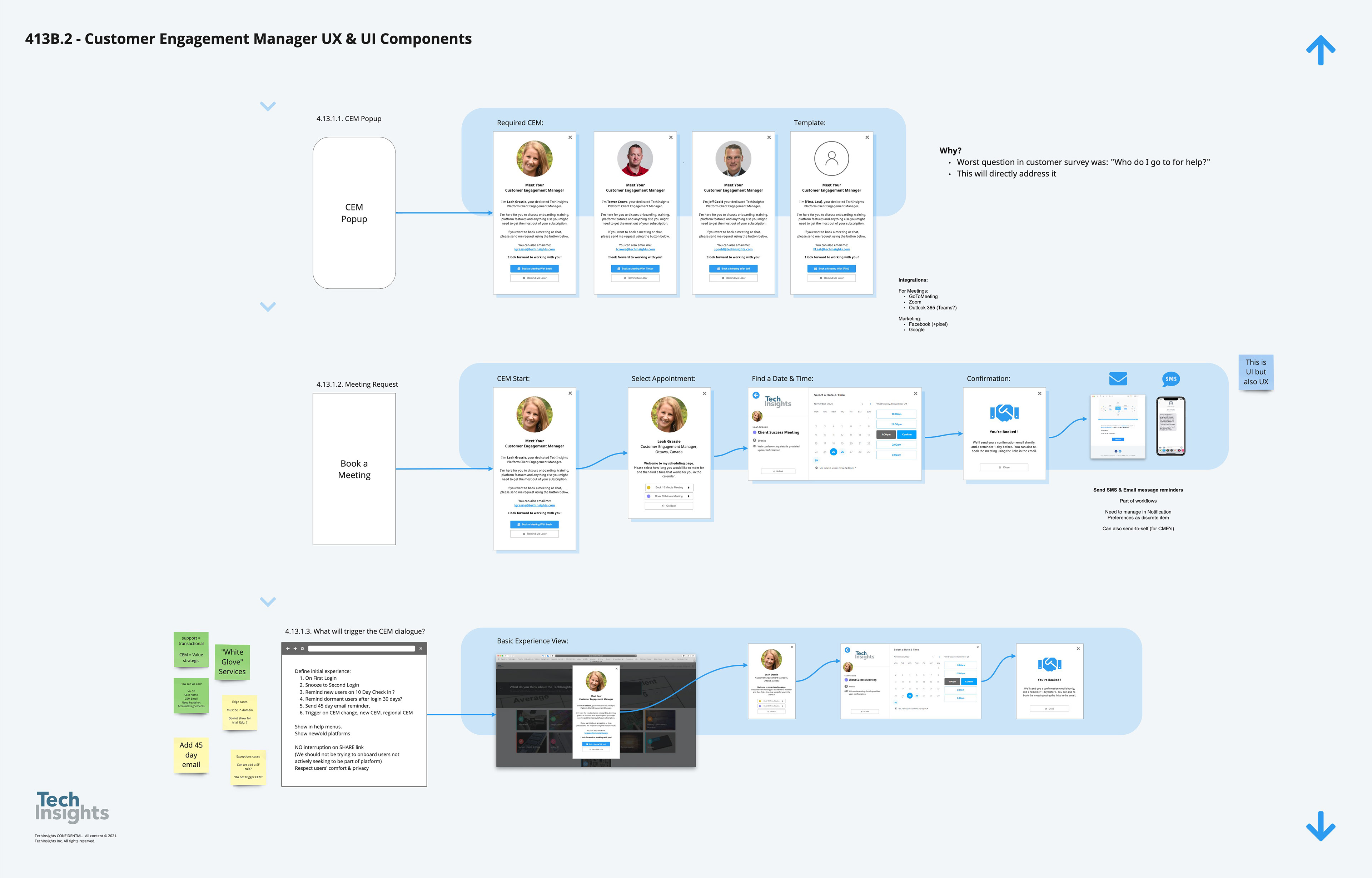Techinsights’ collection of semiconductor analysis and market data is extensive and continually growing. For new customers and users, learning how the reports are organized and categorized is key to discovering interesting and relevant content. Onboarding is a high-touch, personal process led by dedicated Customer Engagement Managers (CEM) to help speed time-to-value discovery through small group or 1:1 meetings.
Role:
Project Lead, UX Design, PM Coordination, Acceptance Testing
Team:
Design Director, VP Marketing, Product Manager
Timeline:
4 weeks: Discovery & Research: 1 wk, Design: 1 wk, Build & Test: 2 wk
Tools:
Miro, Calendly, Jira
Challenge:
During COVID all training and onboarding completely shifted to online webinars and meetings. Educating first-time users to the platform became an involved serious of meetings and follow-ups which were cumbersome to schedule and coordinate. Frequent cancellations resulted in wasted time, and unexpected help requests created unpredictable demand surges for the Customer Success team. Initial engagement hovered around 30% for new users.
Approach:
INVESTIGATION & INTERVIEWS - API REVIEW - SERVICE MAP
CUSTOMER EXPERIENCE - STAKEHOLDER WALKTHROUGH
PROTOTYPES & TESTING - MVP BUILD - ITERATION PLANNING
CUSTOMER EXPERIENCE - STAKEHOLDER WALKTHROUGH
PROTOTYPES & TESTING - MVP BUILD - ITERATION PLANNING
INVESTIGATION:
Our VP Marketing was the key stakeholder for this project and I started by discussing the challenges and a desired outcome of increasing customer onboarding engagement. Then I enlisted the help of 2 different Customer Engagement Managers (CEMs) to discuss their workflows and review customer onboarding feedback. The shift to online training had created a lot of additional communication requirements and the team could not keep up. We needed a solution to increase customer attendance at seminars that did not add more work for CEMs.
These interviews also revealed that customers who could not find what they were looking for usually reported this as a platform bug and then CEMs got pulled into high-priority customer support actions which was a further drain on their time. Platform bug and support logs confirmed these logged requests; this seemed like something else that needed to be addressed.
Solution:
I identified 2 areas we needed to improve that could improve our onboarding and 1:1 service for customers. First, we needed to make customers aware of, and later remind them that contacting their CEM was the desired option when they could not find content. Second, we needed to make it easy to connect both parities, ideally shifting the responsibility to find an reserve a meeting tine to the customer.
The team had already discussed using an online calendar tool to help with scheduling. Calendly was in-use elsewhere in the company so I reviewed the tool online, added it to my business account, and quickly discussed it with our Biz Ops team and confirmed it was a viable tool for us to use as it integrated with our existing CRM and calendar tools with reasonable pricing.
Based on the investigation interviews, I mapped out a Customer Journey to capture onboarding and other communication touch points. Since the CEMs also acted as support during the sales process, I increased coverage of the map to better illustrate the interactions with customers.
Outcome:
Increased direct onboarding meetings with new and existing customers after renewals by +50%. Increased direct user contact with Asia-Pacific customers. This was considered successful but highlighted need for better platform onboarding.
Future:
This feature was directly added into new onboarding flows.



View Design Files